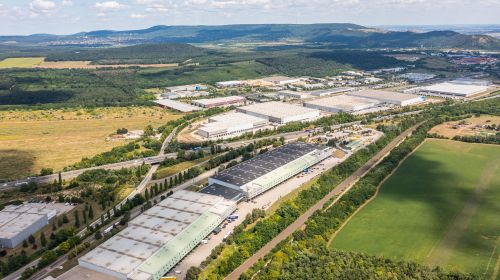Race to the top of the skyline
Office & mixed-use development
Analogies can be misleading, but this one might be useful for some: probably most Europeans have heard such weather forecasts that predict quite pleasant conditions... but with one slight caveat: “At night the temperature could drop below zero at ground level.” The situation is the exact opposite on the CEE real estate markets – although what is happening is not exclusive to this part of the continent. The data here is actually off the scale at ground level. It is hot, but the ‘perceived temperature’ for each country and even for their individual regions is different
A very mixed bag
Office markets in Central Europe have never behaved in the same way. Bearing this in mind, all of these countries are still benefiting from the boom generated by low interest rates.
Warsaw, for example, is experiencing a second flush of youth and is surprisingly looking more attractive as it grows older. Despite all the recent political turmoil, the economy is growing, and the office market is rising to record levels. According to the Polish Office Research Forum, last year around 820,000 sqm of offices were leased in Warsaw. The City Centre (208,400 sqm) and Mokotów district (204,600 sqm) accounted for most of the activity. Most of the leases signed were new contracts – 63 pct, while renegotiations accounted for 26 pct of the volume and expansions for 11 pct. To this set of numbers, one more – the most important of all – needs to be added. According to the ‘Marketbeat. Office Market in Warsaw. Summary of 2017’ report prepared by Cushman & Wakefield, the absorption of office space in Warsaw reached a record of 363,300 sqm. This is at least a very decent result for a market which has recently expanded to a size of 5 mln sqm. And the current year is expected to be no worse. “We can expect a similar result as in 2017,” claims Tomasz Buras, the managing director and head of the investment department at Savills Polska. “Everyone is watching to see to what extent the demand generated by co-working will remain stable and how the market is going to react to it. Some of these tenants have not moved into their offices yet, and will be marketing these areas this year. We will see how the demand for such new space will grow and how it will affect the rental market for traditional office space,” says the head of Savills. There is also a chance for those parts of the city that have been written off by some. “Virtually no new office buildings are being built in Służewiec. This will give the market a chance to stabilise. Infrastructure projects that should improve transport in the area are close to completion and it will look completely different in a year’s time. I believe that Służewiec is already home and dry. Tenants have already appeared that are considering moving there from the city centre,” says Tomasz Buras.
 “We can expect similar figures as for 2017,” predicts Tomasz Buras, the managing director and head of the investment department at Savills Polska
“We can expect similar figures as for 2017,” predicts Tomasz Buras, the managing director and head of the investment department at Savills Polska
He is not the only one who is optimistic about the future. “Despite the coming wave of new supply in 2019–21, the strong tenant activity and, as a result, the falling vacancy rates confirm that the market is still balanced. This year will see relatively low supply and slightly lower vacancy rates. This situation may temporarily shift the balance of power towards tenants, depending on where they are looking for office space. This year, the speed of decision making will be critical, and determine whether an office can be leased in a chosen location,” argues Rafał Wdowczyk, the director of advisory and transaction services for offices at CBRE.
However, this is not the end of the good news on the office market in Poland. Warsaw is doing surprisingly well, but investment in regional cities means that the capital now has to take on domestic competition. Just behind Warsaw comes Kraków, the regional city leader in terms of new office space and the total volume of leasing transactions. According to PORF, a total area of 461,000 sqm of offices was constructed in Polish regional cities over the previous year, most of which – 190,400 sqm – was in Kraków, where in 2017 the total stock breached the 1 mln sqm mark. Poland’s former capital is also the leader among regional cities in terms of the total amount of office space leased. In 2017 it was 200,800 sqm, accounting for almost a third of of all leases in regional cities. Wrocław cannot complain either as tenants leased 169,500 sqm of offices there last year. Łódź has also come into its own as an office location in Poland. It is now a city of interest for such big developers as Skanska, Ghelamco and HB Reavis as well as more local ones. The city’s revitalisation plan, its investor-friendly policies and its growth potential are all encouraging them to open their wallets.
On the same team?
Any analysis of the office market in the Czech Republic would normally begin with Prague. But not this year. Now things are beginning to happen in Brno, where CBRE and Cushman & Wakefield have both decided to open offices. They’ve now turned their attention to the potential of the Moravian office market with its stock of over 700,000 sqm. Brno was not chosen at random – two thirds of the offices in Moravia are located there although Ostrava also has something to boast about with around 220,000 sqm. Obviously, this is nothing compared to the fact that there is app. 3.3 mln sqm of office space in Prague. This number, however, doesn’t tell the whole story. The supply of new space in the Czech capital last year was nothing to write home about, and it didn’t meet tenant demand. Developers have picked up the gauntlet and are currently building over 300,000 sqm in the city, two thirds of which will be completed this year claims JLL. This is no surprise – the total transaction volume on the office leasing market in Prague was 0.53 mln sqm in 2017. Due to the high demand and moderate supply (136,000 sqm in 2017, according to JLL), the vacancy rate in the city fell to of 7.5 pct, a level that had not been seen since 2008. With net absorption it was a similar story.In 2017 it came to PLN 223,000 sqm, the highest it had been for a decade. “In 2018 we expect a supply of more than 200,000 sqm, almost half of which has already been reserved in pre-lease contracts,” says Martin Stričko, a senior analyst at JLL. “It’s safe to say this is not going to significantly change the vacancy rate,” he adds.
Rising prices in Budapest
Office stock in Budapest could any moment now exceed 3.5 mln sqm, since more than 250,000 sqm is currently under construction (according to C&W). With its low vacancy rate of 7.5 pct and high tenant demand (net absorption came to 133,000 sqm in 2017) rents are rising. The best locations can be leased for around EUR 24 per sqm per month, while in the Vaci corridor, which dominates the leasing market in the city, the rate is over EUR 15 per sqm per month. It is no wonder that investors are moving there in droves – and last year’s investment volume of EUR 1.87 bln was only a hair’s breadth lower than at the height of the real estate bubble a decade ago.
Last one out turns off the light
Having taken a look at all these seemingly different cities, a single picture emerges: Central Europe is under construction. You have to ride the wave of the moment, though some have begun to act more in expectation of a coming slowdown. The real estate market is not so different from others in that it is cyclical. One day the slowdown will come and some will come to regret having missed their lifetime chance while others will rue the day that they took it. What can be said about a probability that verges on certainty? The crunch will not begin in Central Europe – the market is not in that league yet. But perhaps that’s a story for the next cycle...






















































